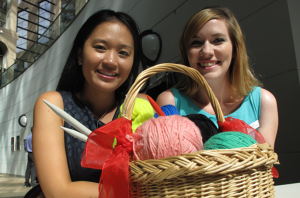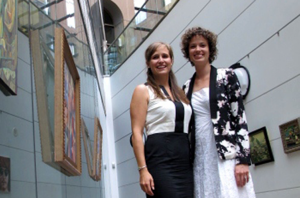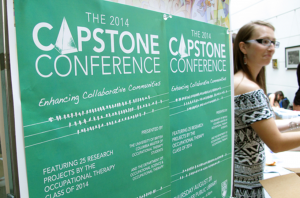
Cabling, purling, and twisting. A year ago, if you were to have asked Laura Brooks and Kim Ta about knitting techniques – they probably wouldn’t have had much to say.
But today, Brooks and Ta can both speak volumes about the craft.
“Knitting has made a come-back in both the craft world and health care,” say Brooks, a soon-to-be graduate of UBC’s Master of Occupational Therapy (MOT) program. “Self-management strategies that are stress-reducing and health-promoting are important for healthy individuals as well as those living with a chronic illness, and we are seeing people of all ages in hospitals, prisons, and formal group therapy settings using knitting.”
Over the past year, as part of their year-long MOT research project, Brooks and Ta conducted in-depth interviews with over twenty members of a community-based knitting group in an effort to understand how engagement in a creative occupation – like knitting – contributes to the health, well-being, and positive identity for people living with or without, a chronic health condition.
“We had a huge interest right off the bat,” says Brooks. “A lot of people have been trying to let their friends and family and health practitioners know how important knitting is for them and that it’s good for their health. This was their opportunity to say everything that they were thinking and feeling about knitting.”
“And it goes far beyond just knitting,” adds Ta, noting the impressive culture that has built up around the craft, with some local knitters travelling miles to local farms to sheer sheep, dye and spin their own wool.
On August 28, Brooks and Ta had a chance to share their study findings at the 9th annual Capstone Conference, held at the Vancouver Public Library.
“We found that knitting has therapeutic implications for mental health and well-being, it has very important social value, cognitive health benefits, it improves and informs a positive identity, and it is also a creative outlet for self-expression,” Brooks and Ta announced to a room full of wide-eyed peers and faculty members – one of whom was knitting.
But Brooks and Ta weren’t the only students to reveal some exciting developments in the field of occupational therapy during the Capstone Conference.
The day-long event was an opportunity for every student part of this year’s Master of Occupational Therapy graduating class to present highlights from their academic work and research in the field of occupational therapy. Studies ranged from examinations on sexuality and sexual function among individuals with spinal cord injury through to the impact of international fieldwork placements.

For Cloe Whittaker and Emily Grant, who studied the experiences of male artists living with chronic illness and disability, the opportunity to present their research findings to their peers was particularly exciting.
“I take away different things each year that I’ve attended the Capstone Conference,” says Whittaker. “This year was very exciting and I had a great experience, but I was surprised at my periodic pangs of nervousness over sharing what were the findings of my first ever research project! I thought that it must be how our participants feel when they share their artwork. It was especially exciting to share our findings because we focused on men – a population that hasn’t yet been given special attention as of yet in this area of OT research.”
“It all went by in a blur,” adds Grant. “It was great to get feedback from peers, faculty, community members and clinicians.”

But the Capstone Conference isn’t just for the graduating class, says Dr. Catherine Backman, head of the Occupational Science and Occupational Therapy (OSOT) department. The event presents an excellent opportunity for incoming students to gain a glimpse of what the future holds for them as they embark on their graduate education. It’s also a chance for the professional community to engage in continuing professional development, hear about a new practice approach, and reflect on up-and-coming research.
“The highlight for me is always the atmosphere created by the students: one of professionalism, pride, a touch of nervousness for some, and a strong sense of community or support for one another. They put their best foot forward and it’s usually clad in a pretty spiffy shoe,” says Backman
And many students – including Whittaker and Grant – plan to take their research one step further after graduation and publish their findings.
Brooks and Ta are also looking to publish their findings on knitting and, over the next several months, will be working with their supervisors towards this goal – taking time, of course, for a few knitting breaks along the way.
For more information about the research conducted by this year’s MOT graduating class, visit the Capstone Conference website.
For full highlights from the day Click Here
Write-up by: Kerry Blackadar
Kerry Blackadar is the Communications Coordinator for the Faculty of Medicine at UBC